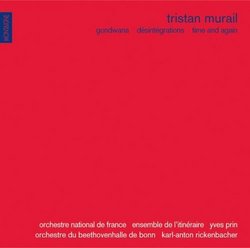| All Artists: Tristan Murail, Yves Prin, Karl-Anton Rickenbacher, Orchestra National de France Title: Tristan Murail: Gondwana; Désintégrations; Time and Again Members Wishing: 3 Total Copies: 0 Label: Disques Montaigne Release Date: 5/18/2004 Genre: Classical Styles: Chamber Music, Historical Periods, Modern, 20th, & 21st Century, Symphonies Number of Discs: 1 SwapaCD Credits: 1 UPC: 822186821756 |
Search - Tristan Murail, Yves Prin, Karl-Anton Rickenbacher :: Tristan Murail: Gondwana; Désintégrations; Time and Again
 | Tristan Murail, Yves Prin, Karl-Anton Rickenbacher Tristan Murail: Gondwana; Désintégrations; Time and Again Genre: Classical |
Larger Image |
CD Details |
CD ReviewsSpectral electro-acoustic music from 1980s France R. Hutchinson | a world ruled by fossil fuels and fossil minds | 08/06/2004 (5 out of 5 stars) "Tristan Murail studied with Messiaen and was a co-founder of the "spectral school" along with Gerard Grisey in the 1970s, but I had not heard of him prior to this Montaigne release of three of his compositions. No longer a young or new composer, nonetheless this important reissue may serve to introduce him to a new audience outside of France. In the three 1980s compositions gathered on this disc, Murail is exploring various possibilities for integrating electronics with acoustic orchestral music. "Gondwana" for orchestra, from 1980, utilizes harmony based on the frequency modulation of digital synthesizers. "Desintegrations" for 17 instruments and computer-generated tape, from 1982-3, uses electronics to produce timbres based on the orchestral instruments. And "Time and Again" for orchestra, from 1986, extends the frequency modulation of "Gondwana" by including a synthesizer interacting with the orchestra. I find these to be beautiful works. If you have heard and enjoy Ligeti and Xenakis, especially, I strongly recommend this music of Tristan Murail. The common ground with Ligeti is the microtonality of Ligeti's "middle period" of the 1960s and 1970s. Ligeti's brief experiments with electronic music ended in the 1950s, though -- Murail's pursuit of electro-acoustic integration places him alongside Xenakis, who pursued an electro-acoustic combination in "Kraanerg" in 1969, one of his masterpieces (see my reviews of the recordings on Asphodel and Col Legno). Apparently these recordings are compiled from earlier releases in other formats, but the combination works brilliantly, progressing from the acoustic waves of "Gondwana" (16'36") to the prominent electronics of "Desintegrations" (22'30") to the agitation and distortion of "Time and Again" (16'47"). After several years at IRCAM in Paris in the 1990s, today Murail is on the faculty of Columbia University's Computer Music Center in NYC. Many thanks to the Montaigne label for rescuing these recordings from oblivion, and bringing attention to a neglected voice of creative, cutting edge modern music. " Three massive ensemble works by one of the major figures of Christopher Culver | 10/03/2008 (4 out of 5 stars) "Tristan Murail belongs to that generation of French composers who found the serialist aesthetic limiting and wanted to pursue a new style based in the actual phenomena of sound. These composers became known as the spectralists, but each of them directed their common interest in overtones, electronics, alternate tunings etc. towards very individual paths. This Naive disc is a good place to encounter Murail's work, featuring three of his early pieces for orchestra. "Desintegrations" for tape and ensemble (1983) is one of the great spectralist masterpieces, endlessly studied and called by many later composers a milestone in new music. As the title suggests, the musical material is based entirely on sound spectras. Murail decomposed various instrumental sounds (especially piano, brass and cello) into their overtones, and then assigned these to the performers, while the tape part is based on artificial spectra generated by electronics. The result is a massive sound mass, sure to appeal to fans of Xenakis and Ligeti. It's quite varied too, with among many other things lovely section of bell chimes, some crunching orchestral sounds, and an ear-tickling exhibition of interference tones. Though the Ensemble L'itinerarire was founded by the spectralists, there is another performance of the piece out with the Ensemble Intercontemporain lead by David Robertson. I favour that EIC recording because it was made at IRCAM and has clearer sound, though the actual performance differs little from here, possibly since any conductor would be a slave of the tape part. If "Desintegrations" goes all over the place, "Gondwana" for orchestra (1980) is much more about stasis. Musical ideas are put forward and then allowed to repeat at great length, while development goes by nearly unperceived. It's incredible here what weird sonorities Murail has come up with totally without the use of electronics. Again we find many bell-like sounds, which seem to be Murail's own personal approach to spectralism compared to other composers in that vein. In "Time and Again" for orchestra and electronics (1985) the composer gives a succession of musical items which each return, though they are often distorted and everything is layered in a nearly impenetrable fog. Only at the end does this fog lift and we hear the real heart of the work, before everything fades out with some really cool weird murmurming like Morse code heard through static. While this disc is often touted as a good introduction to spectralism, I rather prefer Grisey's cycle LES ESPACES ACOUSTIQUES, as each of its parts is so transparent in construction. Nonetheless, if you like contemporary music, Murail is a figure worth encountering and these are some fine pieces. I merely retract a star for the less than ideal recording quality." 20th century masterpiece music junkie | Mariposa, CA | 08/20/2009 (5 out of 5 stars) "Gondwana is the most interesting composition on this CD, but the entire CD gets better after repeated listening. A pity that so few of Murail's compositions are available on CD!"
|
